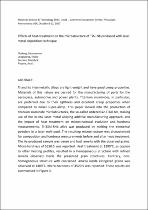 ResearchSpace
ResearchSpace
Effects of heat-treatment on the microstructure of TiAl-Nb produced with laser metal deposition technique
JavaScript is disabled for your browser. Some features of this site may not work without it.
- ResearchSpace
- →
- Research Publications/Outputs
- →
- Conference Publications
- →
- View Item
| dc.contributor.author |
Tlotleng, Monnamme

|
|
| dc.contributor.author |
Lengopeng, Thabo

|
|
| dc.contributor.author |
Seerane, Mandy N

|
|
| dc.contributor.author |
Pityana, Sisa L

|
|
| dc.date.accessioned | 2017-12-14T12:02:15Z | |
| dc.date.available | 2017-12-14T12:02:15Z | |
| dc.date.issued | 2017-10 | |
| dc.identifier.citation | Tlotleng, M. et al. 2017. Effects of heat-treatment on the microstructure of TiAl-Nb produced with laser metal deposition technique. Materials Science & Technology 2017, David L. Lawrence Convention Center, Pittsburgh, Pennsylvania, USA | en_US |
| dc.identifier.uri | http://www.programmaster.org/PM/PM.nsf/ApprovedAbstracts/6CCDF02134D787B9852580F80056E3E8?OpenDocument | |
| dc.identifier.uri | http://hdl.handle.net/10204/9874 | |
| dc.description | Copyright © 2017 MS&T17®. Due to copyright restrictions, the attached PDF file only contains the abstract of the full text item. For access to the full text item, please consult the publisher's website. | en_US |
| dc.description.abstract | Ti and its intermetallic alloys are light-weight and have good creep properties. Materials of this nature are desired for the manufacturing of parts for the aerospace, automotive and power plants. Titanium aluminides, in particular, are preferred due to their lightness and excellent creep properties when compared to nickel super-alloys. This paper looked into the production of titanium aluminide microstructures, the so-called ordered a2-Ti3Al-Nb, making use of the in-situ laser metal alloying additive manufacturing approach, and the impact of heat treatment on microstructural evolution and hardness measurements. Ti-33Al-8Nb alloy was produced by melting the elemental powders in a laser melt-pool. The resulting microstructure was characterised for composition and hardness measurements before and after heat treatment. The As-produced sample was dense and had lamella with the observed grains. Micro-hardness of 5550.5 was reported. Heat treatment at 1200°C, as oppose to other heating profiles, resulted in a homogeneous structure with refined lamella observed inside the preserved grain structures. Contrary, non-homogeneous structure with coarsened lamella inside elongated grains was observed at 1400°C. Micro-hardness of 4520.5 was reported. These results are summarised in Figure 4. | en_US |
| dc.language.iso | en | en_US |
| dc.publisher | MS&T17 | en_US |
| dc.relation.ispartofseries | Worklist;19874 | |
| dc.subject | Hardness | en_US |
| dc.subject | Heat-treatment | en_US |
| dc.subject | Laser | en_US |
| dc.subject | Microstructure | en_US |
| dc.subject | Niobium and Titanium Aluminides | en_US |
| dc.title | Effects of heat-treatment on the microstructure of TiAl-Nb produced with laser metal deposition technique | en_US |
| dc.type | Conference Presentation | en_US |
| dc.identifier.apacitation | Tlotleng, M., Lengopeng, T., Seerane, M. N., & Pityana, S. L. (2017). Effects of heat-treatment on the microstructure of TiAl-Nb produced with laser metal deposition technique. MS&T17. http://hdl.handle.net/10204/9874 | en_ZA |
| dc.identifier.chicagocitation | Tlotleng, Monnamme, Thabo Lengopeng, Mandy N Seerane, and Sisa L Pityana. "Effects of heat-treatment on the microstructure of TiAl-Nb produced with laser metal deposition technique." (2017): http://hdl.handle.net/10204/9874 | en_ZA |
| dc.identifier.vancouvercitation | Tlotleng M, Lengopeng T, Seerane MN, Pityana SL, Effects of heat-treatment on the microstructure of TiAl-Nb produced with laser metal deposition technique; MS&T17; 2017. http://hdl.handle.net/10204/9874 . | en_ZA |
| dc.identifier.ris | TY - Conference Presentation AU - Tlotleng, Monnamme AU - Lengopeng, Thabo AU - Seerane, Mandy N AU - Pityana, Sisa L AB - Ti and its intermetallic alloys are light-weight and have good creep properties. Materials of this nature are desired for the manufacturing of parts for the aerospace, automotive and power plants. Titanium aluminides, in particular, are preferred due to their lightness and excellent creep properties when compared to nickel super-alloys. This paper looked into the production of titanium aluminide microstructures, the so-called ordered a2-Ti3Al-Nb, making use of the in-situ laser metal alloying additive manufacturing approach, and the impact of heat treatment on microstructural evolution and hardness measurements. Ti-33Al-8Nb alloy was produced by melting the elemental powders in a laser melt-pool. The resulting microstructure was characterised for composition and hardness measurements before and after heat treatment. The As-produced sample was dense and had lamella with the observed grains. Micro-hardness of 5550.5 was reported. Heat treatment at 1200°C, as oppose to other heating profiles, resulted in a homogeneous structure with refined lamella observed inside the preserved grain structures. Contrary, non-homogeneous structure with coarsened lamella inside elongated grains was observed at 1400°C. Micro-hardness of 4520.5 was reported. These results are summarised in Figure 4. DA - 2017-10 DB - ResearchSpace DP - CSIR KW - Hardness KW - Heat-treatment KW - Laser KW - Microstructure KW - Niobium and Titanium Aluminides LK - https://researchspace.csir.co.za PY - 2017 T1 - Effects of heat-treatment on the microstructure of TiAl-Nb produced with laser metal deposition technique TI - Effects of heat-treatment on the microstructure of TiAl-Nb produced with laser metal deposition technique UR - http://hdl.handle.net/10204/9874 ER - | en_ZA |





